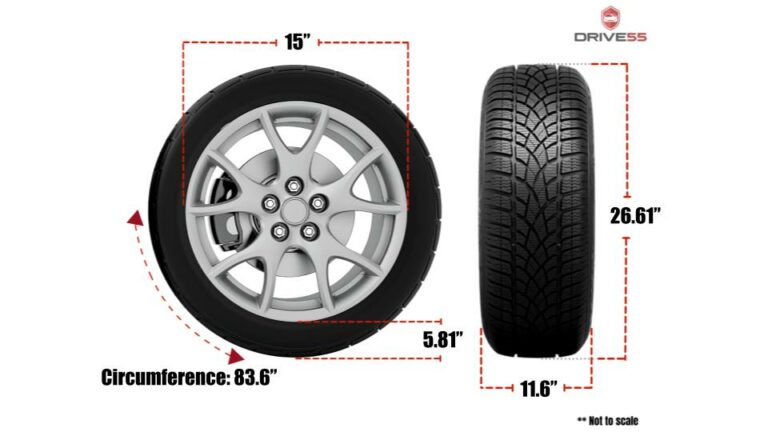How Many Inches Are 295 Tires

Understanding tire sizing can feel like deciphering a secret code, but it's a crucial skill for any DIY mechanic or car enthusiast. Whether you're choosing new tires, assessing wear, or just trying to understand what those numbers on the sidewall mean, knowing how to convert tire size designations to inches is essential. This guide focuses on how to determine the overall width of a 295 tire in inches.
Purpose
Why bother converting metric tire sizes to inches? Several reasons:
- Fitment: Before buying new tires, you need to ensure they'll fit your vehicle's wheel wells and won't rub against suspension components. Knowing the tire's width in inches makes it easier to visualize and measure available space.
- Wheel Selection: Tire width dictates the appropriate wheel width. A 295 tire needs a wheel within a specific width range to ensure proper bead seating and optimal performance.
- Performance: Wider tires *generally* provide more grip, but only if the tire is properly matched to the wheel. Overly wide or narrow tires on a wheel can lead to poor handling.
- Aesthetics: While not purely functional, knowing the exact tire dimensions helps achieve the desired visual stance for your vehicle.
- Troubleshooting: If you're experiencing rubbing or handling issues, knowing the tire's dimensions can help identify the root cause.
Key Specs and Main Parts of a Tire Size Designation
The number "295" in a tire size like "295/35R20" represents the section width. Let's break down the whole designation:
- 295: The section width in millimeters. This is the width of the tire at its widest point when properly inflated and mounted on a wheel.
- 35: The aspect ratio. This represents the sidewall height as a percentage of the section width. In this case, the sidewall height is 35% of 295mm.
- R: Indicates radial construction, the most common tire construction type.
- 20: The wheel diameter in inches. This is the diameter of the wheel the tire is designed to fit.
How It Works: Converting Millimeters to Inches
The key to figuring out the width of a 295 tire in inches is simple unit conversion. Remember that 1 inch equals 25.4 millimeters.
Therefore, to convert 295 millimeters to inches, you divide 295 by 25.4:
295 mm / 25.4 mm/inch = 11.61 inches (approximately)
So, a 295 tire is approximately 11.61 inches wide.
Important Note: Aspect Ratio and Overall Diameter
While we've calculated the width, keep in mind that the aspect ratio (the "35" in our example) affects the overall diameter of the tire. Knowing the overall diameter is also crucial for fitment and ensuring your speedometer reads accurately.
To calculate the overall diameter:
- Calculate the sidewall height: 295 mm * 0.35 = 103.25 mm
- Convert sidewall height to inches: 103.25 mm / 25.4 mm/inch = 4.06 inches
- Since there are two sidewalls (top and bottom), double the sidewall height: 4.06 inches * 2 = 8.12 inches
- Add the wheel diameter: 8.12 inches + 20 inches = 28.12 inches
Therefore, a 295/35R20 tire has an approximate overall diameter of 28.12 inches.
Real-World Use: Basic Troubleshooting Tips
- Rubbing: If you're experiencing rubbing, first confirm the tire size matches your vehicle's specifications (check the door jamb sticker). Then, inspect the wheel offset and ensure it's within the recommended range. Too much or too little offset can cause rubbing. Consider rolling the fender lips or using wheel spacers (with caution and proper installation).
- Handling Issues: Mismatched tire sizes between axles can cause unpredictable handling. Always replace tires in pairs (at least on the same axle) or, ideally, as a set of four. Uneven tire wear can also contribute to handling problems. Regularly check tire pressure and rotation.
- Speedometer Error: Changing tire sizes can affect your speedometer reading. A tire with a significantly different overall diameter than the original equipment tire can cause the speedometer to read high or low. Consider recalibrating your speedometer if you change tire sizes. There are apps and tools available to assist in speedometer recalibration.
- Load Rating and Speed Rating: Always ensure the tires you select have a load rating and speed rating that meets or exceeds your vehicle's requirements. This information is typically found in your owner's manual.
Safety: Risky Components
Tires are critical safety components. Here are some areas of concern:
- Tire Pressure: Maintaining proper tire pressure is crucial for handling, fuel efficiency, and tire life. Check your tire pressure regularly with a reliable gauge. Never exceed the maximum pressure indicated on the tire sidewall. Underinflated tires can overheat and lead to blowouts.
- Tire Wear: Regularly inspect your tires for wear. The wear bars (small raised sections in the tire grooves) indicate when the tire is worn to its minimum legal tread depth. Replace tires when they reach the wear bars or if they show signs of damage such as cuts, bulges, or uneven wear.
- Sidewall Damage: The sidewall is the weakest part of the tire. Inspect the sidewalls for cuts, bulges, or abrasions. Any significant damage to the sidewall can compromise the tire's integrity.
- Age: Tires degrade over time, even if they haven't been used much. Check the DOT code on the tire sidewall to determine the manufacturing date. Consider replacing tires that are more than six years old, regardless of tread depth.
- Wheel Mounting: Ensure wheels are properly torqued to the manufacturer's specifications. Using the correct torque wrench and tightening pattern is critical to prevent wheel loosening.
This explanation provides a foundation for understanding tire sizing and converting measurements. Always consult your vehicle's owner's manual and consult with a tire professional when making tire choices.
